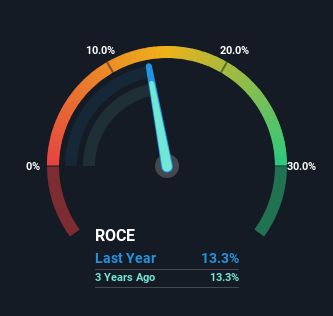- India
- /
- Electrical
- /
- NSEI:MARINE
Returns At Marine Electricals (India) (NSE:MARINE) Appear To Be Weighed Down
Did you know there are some financial metrics that can provide clues of a potential multi-bagger? Firstly, we'd want to identify a growing return on capital employed (ROCE) and then alongside that, an ever-increasing base of capital employed. This shows us that it's a compounding machine, able to continually reinvest its earnings back into the business and generate higher returns. With that in mind, the ROCE of Marine Electricals (India) (NSE:MARINE) looks decent, right now, so lets see what the trend of returns can tell us.
Understanding Return On Capital Employed (ROCE)
If you haven't worked with ROCE before, it measures the 'return' (pre-tax profit) a company generates from capital employed in its business. The formula for this calculation on Marine Electricals (India) is:
Return on Capital Employed = Earnings Before Interest and Tax (EBIT) ÷ (Total Assets - Current Liabilities)
0.13 = ₹339m ÷ (₹5.3b - ₹2.8b) (Based on the trailing twelve months to December 2023).
Therefore, Marine Electricals (India) has an ROCE of 13%. In absolute terms, that's a pretty standard return but compared to the Electrical industry average it falls behind.
Check out our latest analysis for Marine Electricals (India)

While the past is not representative of the future, it can be helpful to know how a company has performed historically, which is why we have this chart above. If you're interested in investigating Marine Electricals (India)'s past further, check out this free graph covering Marine Electricals (India)'s past earnings, revenue and cash flow.
What Does the ROCE Trend For Marine Electricals (India) Tell Us?
While the current returns on capital are decent, they haven't changed much. The company has consistently earned 13% for the last five years, and the capital employed within the business has risen 79% in that time. Since 13% is a moderate ROCE though, it's good to see a business can continue to reinvest at these decent rates of return. Over long periods of time, returns like these might not be too exciting, but with consistency they can pay off in terms of share price returns.
On a separate but related note, it's important to know that Marine Electricals (India) has a current liabilities to total assets ratio of 52%, which we'd consider pretty high. This effectively means that suppliers (or short-term creditors) are funding a large portion of the business, so just be aware that this can introduce some elements of risk. Ideally we'd like to see this reduce as that would mean fewer obligations bearing risks.
Our Take On Marine Electricals (India)'s ROCE
The main thing to remember is that Marine Electricals (India) has proven its ability to continually reinvest at respectable rates of return. And the stock has done incredibly well with a 371% return over the last five years, so long term investors are no doubt ecstatic with that result. So even though the stock might be more "expensive" than it was before, we think the strong fundamentals warrant this stock for further research.
Marine Electricals (India) does have some risks though, and we've spotted 1 warning sign for Marine Electricals (India) that you might be interested in.
While Marine Electricals (India) isn't earning the highest return, check out this free list of companies that are earning high returns on equity with solid balance sheets.
New: Manage All Your Stock Portfolios in One Place
We've created the ultimate portfolio companion for stock investors, and it's free.
• Connect an unlimited number of Portfolios and see your total in one currency
• Be alerted to new Warning Signs or Risks via email or mobile
• Track the Fair Value of your stocks
Have feedback on this article? Concerned about the content? Get in touch with us directly. Alternatively, email editorial-team (at) simplywallst.com.
This article by Simply Wall St is general in nature. We provide commentary based on historical data and analyst forecasts only using an unbiased methodology and our articles are not intended to be financial advice. It does not constitute a recommendation to buy or sell any stock, and does not take account of your objectives, or your financial situation. We aim to bring you long-term focused analysis driven by fundamental data. Note that our analysis may not factor in the latest price-sensitive company announcements or qualitative material. Simply Wall St has no position in any stocks mentioned.
About NSEI:MARINE
Marine Electricals (India)
Manufactures and sells various marine and industrial electrical and electronic components in India and internationally.
Flawless balance sheet with solid track record.
Similar Companies
Market Insights
Community Narratives





